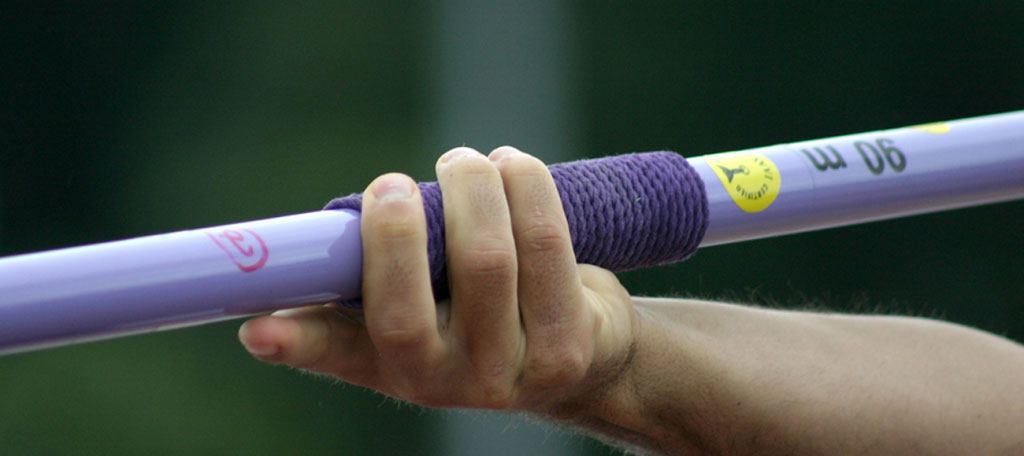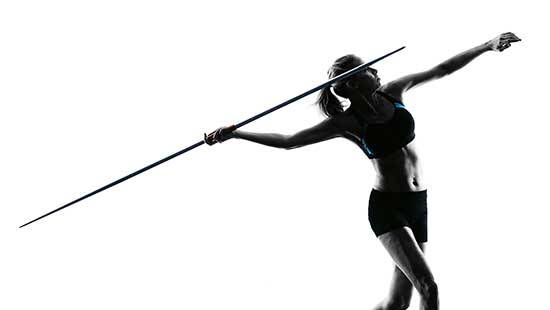
Master's Javelin Throw Technique
Masters Javelin Throw
Still love throwing, training and competing in Masters javelin throwing? We love it too. We train many Masters athletes in the javelin throw to this day and help them improve their throwing and uncover all of the mysteries of this great throwing event.
>> See Javelin Video Below
If you’ve ever wondered about your penultimate stride or impulse step or your hip drive, you’re not alone.
If you’re not sure how to block properly and you’re still stuck make the javelin stick in, we can help. You may even be taking up the event of the first time and be hooked on racing out to the field to do some throwing on a sunny day.
We know your passion and it’s great to hear from people who love throwing just like we do.
As a masters athlete, this may be your first introduction to throwing or you may be continuing your competitive career. If you’re continuing your competitive career, you should have a pretty good idea of what you need to focus on.
However, if this is your first time trying out for throwing, good for you.
Here are some masters javelin basics you should focus on.
Masters Javelin Throw Practice

Warm Up:
- Start with a good warm up of getting the body moving with light jogging, arm circles, shoulder, knee, ankle and trunk rotations.
- Then try some light ball throws. There are weighted balls you can buy on amazon to get you started. Ball throwing is still very important in javelin throwing. If you find that you’re losing technique in the javelin throw, go back to the ball to work on it and smooth things out.
- After ball throwing, you can move to light punching throws with the javelin. These are throws where you throw the javelin into the ground about 10-15 feet ahead of you. Imagine you’re trying to hit a target about the length of a car or car and a half away. This should be a straight throw without any ark.
Masters Javelin Practice Part 1
Your standstill javelin throw is really important even as a masters athlete. You can, and probably should spend a great deal of time in your standstill stance practicing the standstill throw. Jan Zelezny (current world record holder) was known for living in his standstill stance during practice. He genuinely felt this was key for developing his overall throw. At times, he spent up to 2 hours working standstill throws.
Though you don’t need to spend near that amount of time, you can use up to 25-50% of your practice working with standstill throws.
Masters Javelin Practice Part 2
The next area you want to focus on is adding a tiny bit of motion to your movement. This is often where things can become challenging. The standing javelin throw has lots of stability and you have all kinds of time to apply force. Once you start moving, the window to apply force shortens the faster you go.
The key to managing your run up is to start incredibly slowly. Many athletes I’ve trained try to take large penultimate strides and jump into the throw to “create” something. This is understandable because much of the coaching and elite throwers are focused on all out throwing power. This is a very advanced approach that we must build up to. You don’t want to start at this speed.
You must focus on rhythm during these little steps. It’s not about going fast. As you arrive at your penultimate step, don’t try to make it so big that it disrupts your movement. You don’t need to jump or aggressively push off of it. Just let it happen naturally and you’ll be far better off.
Every masters javelin thrower is different and will have differing penultimate strides and cross steps. This is perfectly normal. There’s no need to make yours like anyone else’s or make it bigger because a coach says so.
Your goal should be to take baby steps or “chicken” steps as you ease into a few throws.
We develop our top athletes in this fashion. I never force them to throw from a 3 step or a 5 step. I want them to work rhythm and come in smoothly and in a controlled fashion so they can maintain balance and control.
The throws should have a gentle ark on them and the javelin should stick in the ground.
If you’re having trouble making the javelin stick in the ground, you may be dragging it through without turning it over. We have videos in the Member’s Section to help you with this if you’re really stuck on it.
Masters Javelin Practice Part 3
 Towards the end of your javelin practice, you can attempt some slightly more aggressive throws. This may be 5-6 more serious throws with larger cross steps. You still want your run up to be in control and keep in mind that you don’t have to go that much faster for these throws.
Towards the end of your javelin practice, you can attempt some slightly more aggressive throws. This may be 5-6 more serious throws with larger cross steps. You still want your run up to be in control and keep in mind that you don’t have to go that much faster for these throws.
If you feel like you can’t get good force or a good throwing motion with the more serious throws, you need to slow down and back off a bit.
Javelin throwing is highly technical because the movement is high velocity and not very natural to most people. This is why so much focus is on perfecting a good throwing motion. If you can’t achieve a good throwing motion during your running throws, you must go back to the drawing board and see what’s happening with your javelin throw technique.
Recording some of your throws is a great way to see what’s happening. This will tell you if things are buckling or breaking down as you add speed.
Cool Down
Once you’ve completed your throwing session, it’s a good idea to go for a light jog, loosen things up a bit, get out of the patterns you’ve been performing and have a good stretch.
Javelin throwing is very demanding and it’s a one sided throwing event where each half of the body is doing different things. Make sure you stretch out and keep both sides of your body working properly.
Want to become a better Masters Javelin Thrower?
We have over 80+ javelin training videos athletes can enjoy on all things javelin.
We cover the throwing arm, drive leg, block, run up, off season and so much more.
Common Master Javelin Throw Mistakes
1. Rushing the Throw
One of the most common mistakes I see among masters javelin throwers is trying to rush the throw. The urge to “get it done” is quite common.
Remember, you want to try and create a good “whip” or “sling” motion. You don’t want to try and jolt or shove the throw. Our hips are powerful and if we just hammer them, they can throw everything off.
Remedy:
Articulate the throwing motion in full every time. This is much like a full baseball swing. You don’t want to take a half swing if you’re trying to hit it over the fence. Make sure to take a full and smooth throw each time for best results.
As you get better, you can speed things up but they should always be smooth. The eventual goals is a seamless and powerful throw would good whip.
#2. Jumping at the throw
Once you get the basics of throwing, some masters javelin throwers will have the urge to jump out of their stance during delivery to get the javelin into the air. Top throwers get rotated and flipped into the air as a result of very high level motions. In the case of the masters athlete, it’s more an attempt to get an arc or gain distance by jumping at the throw.
Remedy:
Instead, try to keep your back foot on the ground while you throw and use it to push with. You want your back leg to initiate all the force and maintain contact for the key time interval until the throw is away. Then things can come off the ground as a reaction to the throw but not before.
#3. Sliding the javelin forward.
Imagine the javelin was in a horizontal pipe and you have to shoot it through the pipe when you go to throw. This would force you to kind of slide the javelin forward. This is a big no no because it shortens the distance from your hand to your hip thus shortening your throwing lever.
This can cause the javelin to fly very low and flat and even hit tail first.
Remedy:
If this is really a problem, you can try to arc the javelin with more of a cartwheel pattern throw. As you improve, move away from the cartwheel and practice some in-stance motions where you follow more of a front crawl pattern with your throwing arm.
As you go to apply force, allow your arm to not only move forward but let it come up as if it’s about to reach the top of a front crawl swimming stroke. This will get the javelin moving forward and up instead of just forward. To add to this, lean back a bit to set your throwing angle perpendicular to your block line. If you don’t know some of these terms just yet, that’s ok.
There’s lots of videos in the Member’s Section that explain it all and there’s all kinds of great things to learn about this fun track and field throwing event.
Add distance to your standing and full competitive throws
Find out how world class coach Trevor discusses hip power
Get the proper throwing technique to avoid injury
Sign up for one month with Full Access and cancel any time.

